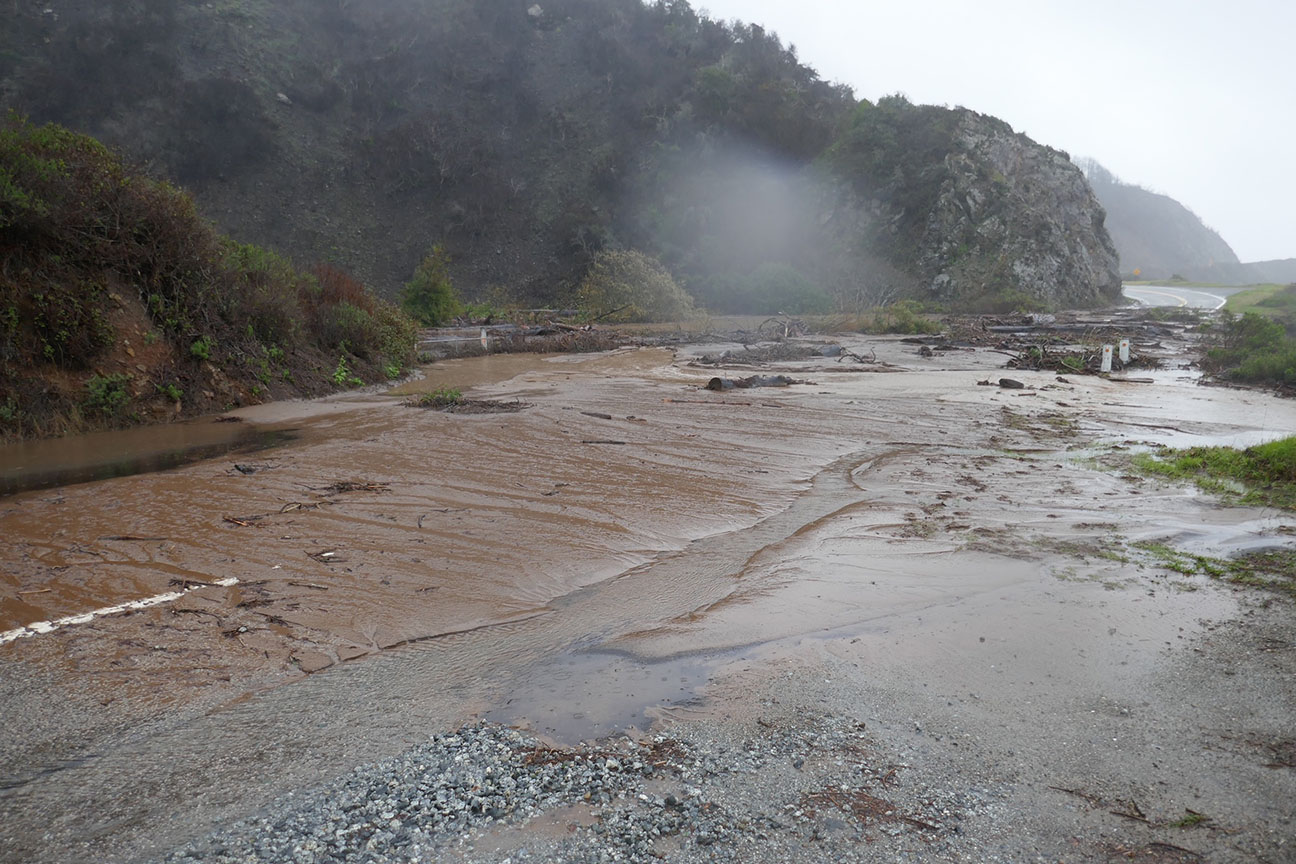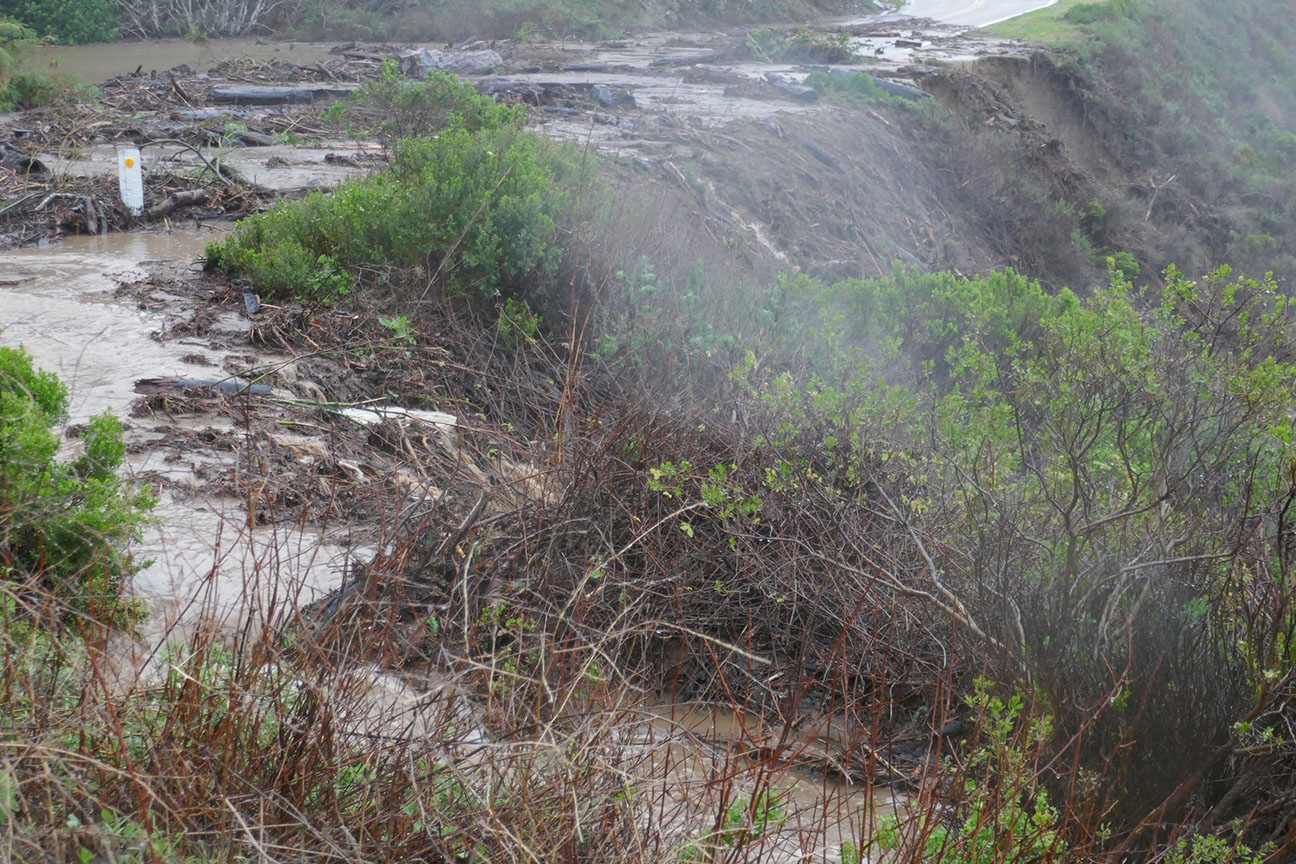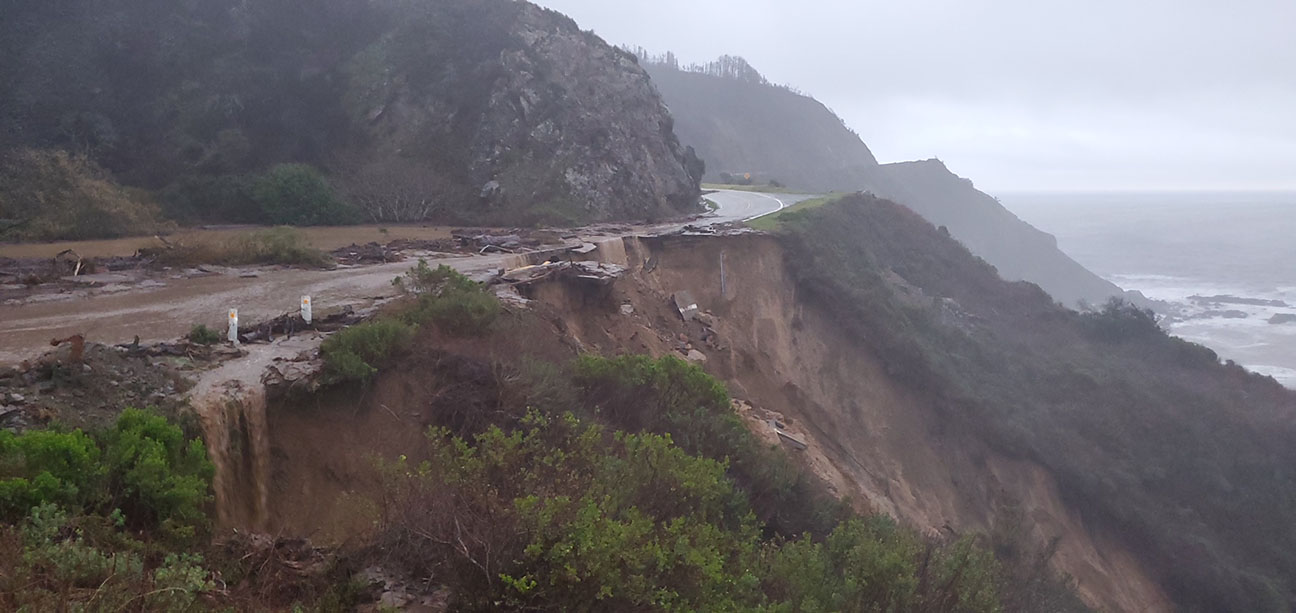CalTrans crews are now working 12 hours a day to fix Highway 1 at Rat Creek | Photo by Dave Nelson
| BIG SUR
By Kate Novoa
Photos by Dave Nelson
Dave Nelson has had a front-row seat to all the action at Rat Creek — from the destruction of Highway 1 to its rebuilding.
He first contacted me on a Wednesday morning, Jan. 27, about what he was witnessing there. He had been in contact with Caltrans, and after our emailed conversations, I also contacted Caltrans by phone later that afternoon. One day later, he watched the highway slowly being eaten by the great equalizer — constant water flow.
Enlarge

Despite this epic destruction six weeks ago, Caltrans has announced that Highway 1 is expected to reopen by early summer. Crews will work 12 hours a day, seven days a week to rebuild a 150-foot section of the scenic, two-lane roadway, said Caltrans spokesman Colin Jones.
I asked Nelson what it has been like to live with the cleanup and construction, which began March 1. “The sound of backup beepers 12 hours a day,” he said. “Occasionally a big bang of a dump truck or excavator on rock. Some days they do knock off a bit early. There’s a generator 24 hours/day running four submersible pumps which keep Rat Creek out of the job site.”
People forget the power of water, but not those Big Surians who live on the edge and have witnessed this power firsthand. We knew we were in trouble when the January forecast predicted a foot of water or more would fall in 24 hours over the Dolan Fire burn scar. Rat Creek is the next creek south of Dolan Creek, where the fire started. Debris flows were inevitable, and Nelson has witnessed them before, most memorably those resulting from the Rat Creek Fire of 1985.
Nelson is turning what others might see as a major inconvenience into a learning experience.
Nelson first came to Big Sur in 1980 to live and work at Esalen. He ended up with a caretaking job at a property just north of Rat Creek two years later.
“As caretaker of the property, I began care of the Rat Creek mutual water system in April of 1982,” said Nelson in an email. “I didn’t know anything, but Richard Trotter was caretaker next door at the Santa Lucia Ranch. Richard was very helpful as was his father, Frank Trotter. The Trotters explained to him the facts of water flow and water systems and how they functioned. The Rat Creek system had one 15,000-gallon redwood tank: “I gradually understood that Rat Creek was a very well-designed system.”
When a new owner bought the Rat Creek parcel that Dave was caretaking, they upgraded the almost 40-year-old system with four 5,000-gallon tanks and bigger pipes and hydrants. “Later, I became operator of Esalen’s two water systems and got licensed. Pipe fitting, repair and water treatment became much of my career.”
The Rat Creek-Gorda Lightning Complex Fire was started by a lightning storm on July 6, 1985. The strike hit a redwood tree on the Dolan Ridge of Big Creek. “I had never been near a wildfire before,” he said. ”Adrenaline overload! I was up for five days running around with my chainsaw.”
Several months later, in October, heavy rain caused a debris flow in several of the canyons in the burn area of the Rat Creek-Gorda Fire, including one at Rat Creek.
Enlarge

On Oct. 17, 1985, Steve Beck called Nelson on CB radio (Nelson didn’t have a phone then) to come see Hot Springs Canyon. A gigantic flood of black water was roaring down the canyon transporting huge logs and boulders. “Mostly, I could HEAR the boulders in the black water. It was scary to descend very far into the canyon,” he said. “It sounded like a jet was landing there.”
That debris flow, which was smaller to this recent one, scoured Rat Creek. It ripped out 600 feet of two-inch galvanized pipe. “A friend helped me replace that pipe with one-inch PVC,” Nelson said. “That pipe was battered by the awesome 1995 rains and 1998 El Nino. The Basin Fire in 2008 slowly plodded its way south and melted that pipe finally. The Basin Fire was much less destructive, generally, than either the Rat Creek Fire of 1985 or Dolan Fire of 2020.”
The Dolan Fire began on Aug. 18. Nelson’s wife woke him to witness the glow on the mountain above them. Originally, they thought it might be from the River Fire, which had started a few days earlier along the western ridge of Salinas Valley. Nelson drove up to the highway turnout at the bottom Dolan Road, where he saw vehicles from Big Sur Fire, the U.S. Forest Service, Monterey County Sheriff’s Office, and the California Parks Department.
He later learned that the alleged arsonist was locked in the back of the State Parks vehicle. (The alleged arsonist, Ivan Gomez, told lawmen a wild story of murder at an illegal marijuana grow that didn’t check out upon further investigation. He is awaiting trial on felony arson charges in Monterey County Court.)
“This was the third time I saw flames just up above my house,” Nelson said. “I noticed again how the fire just petered out as it descended below 500 feet into the cool ocean zone as it did in 1985 and 2008.”
Remembering back to the Rat Creek Fire of 1985, Nelson worried about the potential for debris flow from the Dolan Fire, and he knew it could be serious if the South Coast was hit with a lot of rain in a short amount of time. So he kept an eye on the weather reports.
As the atmospheric river event approached, warnings and evacuation orders were issued and Highway 1 was closed to all travelers, locals and tourists alike, on the evening of Jan. 26. The next day the destruction of the highway at Rat Creek began and proceeded rapidly, and by the third day, a 150-foot chunk of the highway had rattled its way down the cliff on the ocean side before dawn.
This isn’t the last time this will happen. Every winter it is a matter of where, when and for how long.
Crews are now hard at work to fix the destruction nature has wrought, and there are some interesting field studies underway to accompany the work.
There have been as many as10 archeologists at the work site with Native American advisors, going through the strata and marking them, making sure there are no significant archeological sites in the roadway area. They are checking an area on the north side, and a smaller one on the south side.
The contractors have removed what may be several centuries of silt deposits upstream of the highway, according to Nelson. “It looks like overkill to me,” he said, “but I assume they want to have ‘catch basins’ in place to trap sediment from future big events.”
Enlarge

“Everyone has been very nice to us. We’re on a first-name basis with several of the players. Many Caltrans people come and go, including geological types who were fascinated to see a ‘once in a lifetime’ kind of event. I saw markers defining different strata of the newly exposed stream channel and I’m requesting they tell me about their findings.”
Nelson is turning what others might see as a major inconvenience into a learning experience and an opportunity to become even more familiar with this land he occupies.
For now, those of us south of the slide who need to go north, as I did for my first COVID shot, must drive south to get north. It was 225 miles one way to Monterey from my home last week. My friend Rock Knocker and I are lucky. He has an RV, so we go in the day before and come home the day after, going to a favorite place for lunch in an outdoor dining space, or picking up something to go. It is now such a distance that we treat it as a mini-vacation.
Those of us on the South Coast are used to road closures, and extended ones are not unheard of. During closures, everything slows down even more, particularly in winter. We are treated to a silence we have missed and wildlife that becomes visible in its return.
For those of us not dependent on the tourist trade, it is one of our favorite times here on the coast, when Mother Nature returns us to our roots and the earlier years of Big Sur living. She demands our attention in fascinating ways.
This isn’t the last time this will happen. Every winter it is a matter of where, when and for how long. Many of us enjoy the certainty of these winter events when we get to learn about ourselves, our neighbors and this majestic land that can be quite temperamental.
Have something to say about this story? Send us a letter.